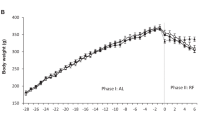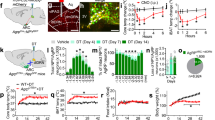Abstract
Food restriction leads to a paradoxical increase in physical activity and further suppression of food intake, such as observed in anorexia nervosa.1,2 To understand this pathophysiological process, we induced physical hyperactivity and self-starvation in rats by restricting food in the presence of running wheels. Normally, decreased melanocortin receptor activity will prevent starvation.3,4 However, we found that self-starvation increased melanocortin receptors in the ventral medial hypothalamus, a brain region involved in eating behavior.5 Suppression of melanocortin receptor activity, via central infusion of Agouti-related protein (AgRP), increased survival rate in these rats by counteracting physical hyperactivity, food intake suppression as well as deregulated body temperature. We conclude that self-starvation may result from insufficient suppression of central melanocortin receptor activity.
This is a preview of subscription content, access via your institution
Access options
Subscribe to this journal
Receive 12 print issues and online access
$259.00 per year
only $21.58 per issue
Buy this article
- Purchase on Springer Link
- Instant access to full article PDF
Prices may be subject to local taxes which are calculated during checkout



Similar content being viewed by others
References
Routtenberg A, Kuznesof AW . Self-starvation of rats living in activity wheels on a restricted feeding schedule. J Comp Physiol Psychol 1967; 64: 414–421.
Bergh C, Sodersten P . Anorexia nervosa, self-starvation and the reward of stress. Nat Med 1996; 2: 21–22.
Huszar D, Lynch CA, Fairchild-Huntress V, Dunmore JH, Fang Q, Berkemeier LR et al. Targeted disruption of the melanocortin-4 receptor results in obesity in mice. Cell 1997; 88: 131–141.
Chen AS, Metzger JM, Trumbauer ME, Guan XM, Yu H, Frazier EG et al. Role of the melanocortin-4 receptor in metabolic rate and food intake in mice. Transgen Res 2000; 9: 145–154.
Bray GA, York DA . Hypothalamic and genetic obesity in experimental animals: an autonomic and endocrine hypothesis. Physiol Rev 1979; 59: 719–809.
Licinio J, Wong ML, Gold PW . The hypothalamic–pituitary–adrenal axis in anorexia nervosa. Psychiatry Res 1996; 62: 75–83.
Hebebrand J, van der Heyden J, Devos R, Kopp W, Herpertz S, Remschmidt H et al. Plasma concentrations of obese protein in anorexia nervosa. Lancet 1995; 346: 1624–1625.
Vaisse C, Clement K, Guy-Grand B, Froguel P . A frameshift mutation in human MC4R is associated with a dominant form of obesity. Nat Genet 1998; 20: 113–114.
Krude H, Biebermann H, Luck W, Horn R, Brabant G, Gruters A . Severe early-onset obesity adrenal insufficiency and red hair pigmentation caused by POMC mutations in humans. Nat Genet 1998; 19: 155–157.
Barsh GS, Farooqi IS, O'Rahilly S . Genetics of body-weight regulation. Nature 2000; 404: 644–651.
Butler AA, Kesterson RA, Khong K, Cullen MJ, Pelleymounter MA, Dekoning J et al. A unique metabolic syndrome causes obesity in the melanocortin-3 receptor-deficient mouse. Endocrinology 2000; 141: 3518–3521.
Yaswen L, Diehl N, Brennan MB, Hochgeschwender U . Obesity in the mouse model of pro-opiomelanocortin deficiency responds to peripheral melanocortin. Nat Med 1999; 5: 1066–1070.
Burden VR, White BD, Dean RG, Martin RJ . Activity of the hypothalamic–pituitary–adrenal axis is elevated in rats with activity-based anorexia. J Nutr 1993; 123: 1217–1225.
Hahn TM, Breininger JF, Baskin DG, Schwartz MW . Coexpression of AgRP and NPY in fasting-activated hypothalamic neurons. Nat Neurosci 1998; 1: 271–272.
Mizuno TM, Makimura H, Silverstein J, Roberts JL, Lopingco T, Mobbs CV . Fasting regulates hypothalamic neuropeptide Y, agouti-related peptide, and proopiomelanocortin in diabetic mice independent of changes in leptin or insulin. Endocrinology 1999; 140: 4551–4557.
Nijenhuis WA, Oosterom J, Adan RA . AgRP(83-132) acts as an inverse agonist on the human melanocortin-4 receptor. Mol Endocrinol 2001; 15: 164–171.
Von Frijtag JC, Croiset G, Gispen WH, Adan RA, Wiegant VM . The role of central melanocortin receptors in the activation of the hypothalamus–pituitary–adrenal-axis and the induction of excessive grooming. Br J Pharmacol 1998; 123: 1503–1508.
Marks DL, Ling N, Cone RD . Role of the central melanocortin system in cachexia. Cancer Res 2001; 61: 1432–1438.
Ste Marie L, Miura GI, Marsh DJ, Yagaloff K, Palmiter RD . A metabolic defect promotes obesity in mice lacking melanocortin-4 receptors. Proc Natl Acad Sci USA 2000; 97: 12 339–12 344.
Hagan MM, Rushing PA, Pritchard LM, Schwartz MW, Strack AM, Van Der Ploeg LH et al. Long-term orexigenic effects of AgRP-(83–132) involve mechanisms other than melanocortin receptor blockade. Am J Physiol Regul Integr Comp Physiol 2000; 279: R47–R52.
Graham M, Shutter JR, Sarmiento U, Sarosi I, Stark KL . Overexpression of AgRT leads to obesity in transgenic mice. Nat Genet 1997; 17: 273–274.
Wirth MM, Giraudo SQ . Agouti-related protein in the hypothalamic paraventricular nucleus: effect on feeding. Peptides 2000; 21: 1369–1375.
Murphy B, Nunes CN, Ronan JJ, Hanaway M, Fairhurst AM, Mellin TN . Centrally administered MTII affects feeding, drinking, temperature, and activity in the Sprague–Dawley rat. J Appl Physiol 2000; 89: 273–282.
Butler AA, Marks DL, Fan W, Kuhn CM, Bartolome M, Cone RD . Melanocortin-4 receptor is required for acute homeostatic responses to increased dietary fat. Nat Neurosci 2001; 4: 605–611.
Adage T, Scheurink AJ, de Boer SF, de Vries K, Konsman JP, Kuipers F et al. Hypothalamic metabolic and behavioral responses to pharmacological inhibition of CNS melanocortin signaling in rats. J Neurosci 2001; 21:3639–3645.
Vink T, Hinney A, van Elburg AA, van Goozen SHM, Sandkuijl LA, Sinke RJ et al. Association between an agouti-related protein gene polymorphism and anorexia nervosa. Mol Psychiatry 2001; 6: 325–328.
van Dijk G, Donahey JC, Thiele TE, Scheurink AJ, Steffens AB, Wilkinson CW et al. Central leptin stimulates corticosterone secretion at the onset of the dark phase. Diabetes 1997; 46: 1911–1914.
Vrinten DH, Gispen WH, Groen GJ, Adan RA . Antagonism of the melanocortin system reduces cold and mechanical allodynia in mononeuropathic rats. J Neurosci 2000; 20: 8131–8137.
Bruijnzeel AW, Stam R, Croiset G, Wiegant VM . Long-term sensitization of cardiovascular responses after a single stressful experience. Physiol Behav 2001; 72: 1–6.
van der Kraan M, Adan RA, Entwistle ML, Gispen WH, Burbach JP, Tatro JB . Expression of melanocortin-5 receptor in secretory epithelia supports a functional role in exocrine and endocrine glands. Endocrinology 1998; 139: 2348–2355.
Author information
Authors and Affiliations
Corresponding author
Rights and permissions
About this article
Cite this article
Kas, M., van Dijk, G., Scheurink, A. et al. Agouti-related protein prevents self-starvation. Mol Psychiatry 8, 235–240 (2003). https://doi.org/10.1038/sj.mp.4001206
Received:
Revised:
Accepted:
Published:
Issue Date:
DOI: https://doi.org/10.1038/sj.mp.4001206
Keywords
This article is cited by
-
AgRP neurons coordinate the mitigation of activity-based anorexia
Molecular Psychiatry (2023)
-
Melanocortin receptor-mediated effects on obesity are distributed over specific hypothalamic regions
International Journal of Obesity (2011)
-
Viral Mediated Neuropeptide Y Expression in the Rat Paraventricular Nucleus Results in Obesity
Obesity (2007)
-
The role of leptin in anorexia nervosa: clinical implications
Molecular Psychiatry (2007)



